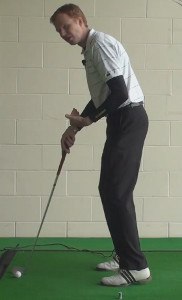
If you tend to hit shots off the heel of the clubface – the portion closest to the shaft – the solution likely lies in your address position. Here are three common causes.
- Standing too close to the ball: From this position you'll extend the arms on the downswing past their address position, pushing the club outward and initiating heel contact.
- Arms slack at address: Similarly, if your arms are bent inward or “soft” at setup, you'll naturally extend them toward the ball coming down.
- Weight toward your toes: If you're leaning over too much, the club will trace a downswing path farther from your body than the route it followed on the backswing. This tipping motion can happen during the swing, even if your balance is solid at address.
Some players, including pros, fix heel contact simply by addressing the ball slightly toward the clubs toe. That way, when the arms extend on the downswing the clubface meets the ball on the sweet spot.
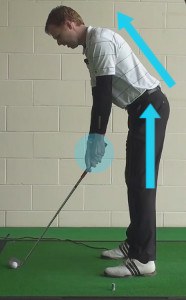
If your issue is a faulty address (standing too close/arms slack), here's an easy way to position yourself the correct distance from the ball based on your stature and posture. Best of all, it works with every club in the bag:
- With the ball in front of you at a distance that feels appropriate, stand up straight (as though standing at attention) and bend your knees slightly.
- Take your normal grip on the club and hold it straight out in front of you, at a right angle to your spine, with the butt end pointing at or just above your belt buckle. Your elbows should be relaxed and at your sides.
- Flex your knees to balance weight on the arches of your feet.
- Bend over from the hips – not the waist -- and let the club fall into place behind the ball.
- If the clubface doesn't reach the ball, or sits beyond it, maintain your knee flex, spine angle and arm position and move your feet forward or back until the club is properly positioned.
Dont adjust the clubs position by moving the arms in or out, bending over farther or standing up straighter. You've already achieved the correct posture, flex and balance.
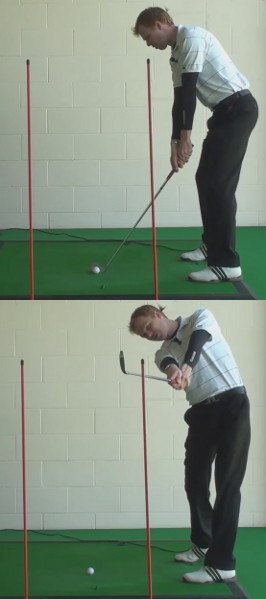
Heel Hit drills
Continually striking the ball on the heel or toe can be extremely frustrating. Many players can feel precisely where the ball strikes the club face. However, some fail to understand where the ball strikes the club face. A simple solution is to use a dry erase marker and color the face of your iron or wood. Next, hit a few shots and check where the ball makes contact on the club face. Re-apply the marker on the club face after a few strikes. You will quickly learn your tendencies so you can create a game plan for more solid strikes. Practice the following heel hit drills to improve contact and sharper your game.
Gate Drill
The Gate Drill is a common drill used on the putting green. Simply place two tees slightly wider than the putter and practice your stroke without hitting the tees. However, this simple drill can transfer over to a chip, pitch or even full swing.
Place your club down head down at address and set the first tee just inside the heel and the other slightly outside the toe. The tees should allow just enough space for the club head to travel through the tees and strike the ball.
The correct impact will miss the tees and take a divot with an iron. If impact is near the toe you will hit the inside tee. Impact near the heel will cause you to strike the outside tee. This is a great heel hit drill that offers instant feedback. Start with practice swings and slowly switch to half swings. Once you can avoid the tees with a half swing then try a full swing.
Alternate Gate Drill
Set two tees similar to the Gate Drill, just inside the heel and outside the toe of the club head. Players that struggle with heel hits should set up with the club face behind the outside tee and make a swing and return to strike the inside tee. On the other hand, players that strike the ball on the toe can do just the opposite, set up to the inside tee and return the club to the outside tee at impact. Go slow in the beginning so you feel yourself groove the difference in motion.
Gradually make a regular swing toward the respective tee. Next, place a ball on the tee and try to hit it. Therefore, to fix the heel hit, place a ball on the inside tee and set up with the club behind the outside tee. Swing the club and hit the ball on inside tee. This opposite motion will help you find the center of the club face for more consistent and accurate golf shots.
Closed Stance Drill
Many amateurs violently swing the club down from the top of the backswing with the hands and arms rather than the proper sequence of the lower body, upper body followed by the arms. The incorrect sequence causes contact on the heel when the club head swings across the ball from outside the target line. If you want to fix a heel hit the correct path should allow the club to travel from the inside. If you are guilty of swinging across the line try hitting with a closed stance. Simply align your body slightly to the right and attempt to hit the inside portion of the ball while swinging out to the right. This is a completely opposite motion and a good heel hit drill for better ball striking.

Shanks and Heel Hits
If you have ever seen the movie Tin Cup you have witnessed how frustrating and quickly shanks can ruin your game. Luckily for Roy McAvoy, he found a solution just in time for the US Open.
If you examine the wear marks on your irons many amateur golfers regularly impact the ball on the toe. However, a high percentage wear out the heel of the club face. The heel is located on the inside of the club head toward the hosel. The good news is a shank is only 2 inches from a perfect strike.
A “shank” is one of the most frustrating shots in golf. Think of a shank as an extreme miss that strikes the heel of the club face. Shanking the ball shatters confidence and often leads to continued shanks. A shank occurs when the ball strikes the hosel of an iron and causes the ball to shoot off to the right (for a right handed golfer). The hosel is the small rounded area that connects the shaft to the club face. Obviously, you want the ball to strike the sweet spot located in the center of the clubface.
Set Up Correctly
Allow your arms to hang under your shoulders. Setting up in the correct position will allow your arms the correct amount of space to swing past your body. Standing too close to the ball can lead to a shank. Standing slightly farther back could change impact from the hosel to the center of the club.
Poor Impact Position
Allow your hands to return back to impact in a similar position as your set up. Shanks and heel hits sometimes occur when the arms and hands extend out and closer to the ball through impact. Therefore, swing your hands and arms closer to your body, specifically your left thigh. If your hands and arms extend a few inches out at impact the clubface will also move out a few inches. Contact with the ball moves from the center of the clubface to the hosel resulting in a shank.
Maintain Balance
Maintain better balance with a smooth tempo throughout the swing sequence. Avoid standing up or forward on your toes through impact. Focus on maintaining your balance and keep your head from moving closer to the ball. The swing should be a rotational movement around your spine angle. Therefore, maintain your spine angle throughout the swing and focus on the rotational movement and avoid any unwanted lateral movement.
Swing Path
Cutting across the ball can lead to a shank. This is known as an outside to inside swing path. Starting the downswing with the upper body often leads to the steep downswing.
A simple drill to alter a swing path involves the use of a cardboard box used to ship golf clubs. Visit any golf shop and ask for a box since they routinely receive inventory from a variety of club manufacturers. Head to the practice range and place the cardboard box parallel to the target line and 4 inches to the outside of the golf ball. Swing without hitting the cardboard box. When you can swing without hitting the cardboard box you have successfully altered the outside to inside swing path.
Follow Through
Accelerate through impact. Decelerating on the downswing often leads to a shank or heel hit. In addition, focus on maintaining your spine angle and follow through. Simply finishing your swing will often produce more solid golf shots. Many shanks around the green result from a large backswing while the body stands up or moves toward the ball without a follow through.
Shank Drills
Some players can eliminate an unwanted movement when they understand the exact opposite motion. Therefore, learn how to control the club face and feel the position of the club head during the swing. If you struggle with shanks and heel hits learn to feel the toe of the club and try to hit the ball on the toe. Once you realize how the arms, hands and club feel in the extreme opposite position you might curb misses on the hosel.
There are many drills that help eliminate several swing faults. Practice maintaining a steady head with the help of a friend or coach. The idea is to create minimal movements with your head throughout the swing. Therefore, have a coach stand in front of you, stretch out his hand and hold your head while you make swings. Obviously your partner must stand far enough away so you don't hit him. Your coach will stabilize any movement, especially forward movement toward the ball while he holds your head in place. This allows you to properly swing your arms and club around the body. When your coach is not around visualize your head placed against a wall so your body can not move forward. If your body and head remain stationary you have reduced the likelihood of forward movement resulting in a shank or heel hit.
Shanks occur when you can not pinpoint the middle of the clubface and the hosel moves forward toward the ball at impact. Place a tee in the ground between you and about an inch from the ball. Practice making swings so the heel of the club strikes the tee through impact. If the hosel returns to the tee you can not shank the ball.
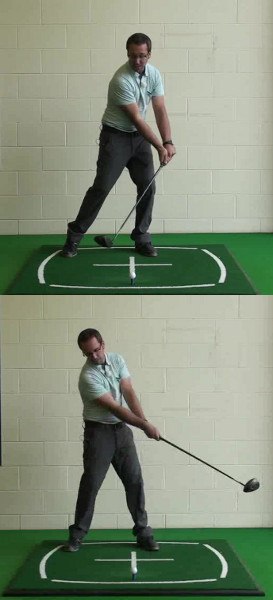
Heel Hits with Driver
Heel hits with the driver typically result in a slice and loss of distance. Coming over the top with an outside to inside swing path is probably the most common reason for a heel hit with the driver. The club head cuts across the target line during the outside to inside swing path. In addition, the swing path creates unwanted side spin that results in a slice. Amateurs that try to swing harder or over correct the motion end up pulling the ball left of the intended target. The initial direction is left, however, with an open club face the ball slices back toward the middle. While the ball might end up in play, there is a tremendous loss of distance due to the inefficient swing sequence.
Proper Grip
Make sure to start with the proper grip. The grip is one of the most important and overlooked fundamentals in the golf swing. Your hands have a direct correlation to the club face throughout the swing. Poor contact is often the result of gripping the club too tightly so the muscles fail to work properly throughout the swing. In addition, a weak grip makes it nearly impossible to hit the ball straight.
Grip the club with the correct tension level. A good grip should be tension free. On a scale of 1-10, your grip pressure should not exceed 4. Sam Snead commonly said imagine placing a bird in your hand and grip the club with the same tension level as holding the bird in place. If you grip too tightly you will squeeze the bird.
Place your hands on the club correctly to avoid a weak grip. A weak grip makes it difficult to square or close the club through impact. When you grip the club you will form a "V" between your index finger and thumb on both hands. The "V" on the left hand should point between the right ear and right shoulder and the "V" on your right hand should point in the same direction. This also assures your hands are working together throughout the swing. When you grip the club with your left hand, you should see a minimum of two knuckles. If you see less you are probably gripping the club incorrectly.
Weight Distribution
Address the ball with your weight near the balls of your feet rather than back on your heels. During the swing your body needs to remain balanced, however, when you start on your heels a common tendency is to move forward on your toes. If your weight moves forward to the toes your body will most likely move forward toward the ball. The forward body movement can easily push your arms, hands and club a few inches closer to the ball and result in a heel hit with the driver.
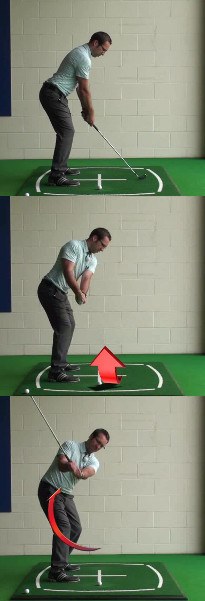
Eliminate Heel Hits with Flatter Swing Plane
The over the top swing fault creates an outside to inside swing path. One of best ways to eliminate the outside to inside swing path is to create a flatter swing. The steep downswing often leads to heel hits. Therefore, eliminate heel hits with flatter swing planeand create solid contact in the center of the club face.
Swing plane is defined as the angle you swing the club around your body. An easy way to understand the swing plane is to observe where the butt end of the grip points throughout the swing. The target line also helps in the explanation of the swing plane. The target line is an imaginary line that runs through the golf ball in both directions.
Begin by taking a set up and making a practice swing. Once the club reaches waist high, your wrists will hinge and the end of the club will begin to point down toward the ball. During the backswing, downswing and forward swing the butt end of the grip points down toward the ground. However, keep the butt end of the grip pointing toward the target line for as long as possible.
A steep swing plane will position the butt end of the grip between your toes and the target line. In extreme situations, it can be compared to the motion of chopping wood with an axe. On the other hand, a swing plane that is too flat will position the end of the grip toward the opposite side of the target line. In extremely flat swings, it is similar to the motion of swinging a baseball bat. Steep swings generally create a ball flight that start left of the target while a flat swing plane generally creates a ball flight that starts to the right of your target. Many players with an over the top downswing will feel a much flatter swing plane when the grip points down the target line. In addition, you can eliminate heel hits with a flatter swing plane. In reality, the swing plane is now similar during the backswing and downswing.
There are several products and drills promising to transform your game and swing. Unfortunately, many players fail to create any positive change in their swing. Over the years I have seen many beneficial drills and swing aids, yet one of the most effective golf swing drills is referred to as the “Grip Down Drill.” Personally, I have used the drill to ingrain the proper movements in my swing since I participated in junior golf over 20 years ago. There are very few drills that provide instant feedback while versatile enough to practice anywhere, including the comfort of your own home.
The Grip Down Drill is beneficial to learn the proper movements including the swing plane, swing path and release of the golf club. This is a beneficial drill to eliminate heel hits with a flatter swing plane. Begin by taking a normal stance. Place a club or alignment stick on the ground parallel to your feet so it represents the target line. Place your hands on the shaft just below the grip. The grip should point toward your stomach and the club head should hover about 12 to 18 inches off the ground, about knee height. Start your swing back and once the club reaches waist high your wrist will hinge. The butt end of the grip should point down toward the target line. If it points toward your toes or other side of the ball the swing plane is slightly off. The butt end of the grip should point toward the target line during the backswing and downswing. Since you swing the club around your body in a circle the butt end of the grip will again point down toward the target line once the club passes the impact position.

Early Extension Heel Hits
Many swings faults are the direct result of a physical limitation in the swing. Early extension is a swing fault defined as any forward thrust of the lower body toward the golf ball during the downswing. Early extension is one of the most common swing characteristics. Early extension causes the arms and club to get stuck behind the body while the torso stands up during the downswing. Amateurs that early extend feel the club is stuck or trapped since the lower body moves closer to the ball. Therefore, the body is in the way while the arms and club feel stuck or extend closer to the golf ball. The miss of early extension usually includes a block to the right or a hook.
The problem with players that create an early extension is their body moves closer to the target. When the body moves closer that can also push the arms, hands and club closer to the golf ball. Consequently, when everything moves closer to the ball you increase the likelihood of a heel hit or shank. Without a compensation early extension can lead to heel hits.
Physical limitations such as the inability to perform a full deep squat or full hip bend can cause a player to early extend during the downswing. In addition, these physical limitations often lead to poor posture at address and a loss of the spine angle throughout the swing.
Early Extension Test
A simple test for early extension is the full deep squat. If you can not complete a deep squat than early extension is potentially a physical problem. Begin by standing straight up, extending your arms out with your thumbs up in the air. Next, place your thumbs back on your shoulders so your elbows point in front of you. Make sure your toes are pelvic width apart and point straight in front of you. Keeping both heels on the ground, begin to squat as far down as you can go. A full squat allows the thighs to go past parallel with the ground and your butt should be below your knees. Full mobility allows you to go all the way down and return back to your starting position. If you cant complete the squat, the lack of mobility and stability in your body is potentially causing you to early extend in your downswing. By correcting a physical limitation such as early extension you will should make better contact with the ball and avoid heel hits.
If you create early extension heel hits contact a physical trainer to develop an exercise program that eliminates this unwanted swing characteristic.






